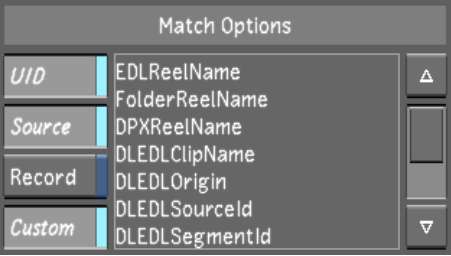A change cut allows you to apply the grade settings from the current cut to the new cut you are loading.
For example, assume you create a grade with a cut file. You then receive a new EDL and create a new cut from it. This new cut is similar to the first one because it uses many of the same shots, so you would like to use the grade settings that are already done to prevent manually reloading individual grade settings. You load the grade with the original cut, and then change to the new assembled cut. The grade settings that were in the original cut are transferred to the shots that correspond to the Match Options (described below).
The grade is applied to the new cut based on the Match Options (i.e., UID, Source, Record, and Custom). You can base the match on one or multiple options. By default, UID, Source, and Custom are enabled.



| Select: | To: |
|---|---|
| UID | Match the unique ID of the shots in the original cut to the new cut. |
| Source | Match the tape/reel name, source ID, and source timecode of the original cut to the new cut. |
| Record | Match the record timecode of the original cut to the new cut. |
| Custom | Match the original cut to the new cut based on the keyword that is selected in the custom list. |
If the Custom option is enabled, there is a list of keywords to which you can associate the custom option.
| Select: | To: |
|---|---|
| EDLReelName | Match the reel name of the EDL. |
| FolderReelName | Match the folder reel name. |
| DPXReelName | Match the DPX reel name. |
| DLEDLClipName | Match the clip name of the shot coming from the Wiretap server. |
| DLEDLOrigin | Match the image import path and file name of the timeline coming from the Wiretap server. |
| DLEDLSourceId | Match the media source’s unique ID of the timeline coming from the Wiretap server. |
| DLEDLSegmentId | Match the segment’s unique ID of the timeline coming from the Wiretap server. |
| DLEDLStartTc | Match the start source timecode of the timeline coming from the Wiretap server. |
| DPXKeycodeStart | Match the DPX header keycode start. |
| DPXKeycodeEnd | Match the DPX header keycode end. |
| EDLComment | Match the unique comment that is applied to the original cut from another application. |
The more match options that are enabled, the easier it is to complete an accurate change cut. For example, if you enable UID, Source, and Custom, the same shot can be in the timeline numerous times and the grade will be matched according to the shot’s unique ID, tape/reel name, source ID, source timecode, and the custom option you have selected.
Lustre can also apply grading to a new cut on a shot-to-shot (and layer-to-layer) basis, regardless of any matching criteria. This is similar to a direct transfer of grading, depending upon the location of the shots within the timeline. To apply this type of change cut, disable all of the Match Option buttons.
For example, if the original cut is a single layer with two shots, the grade is applied to the new cut’s first two shots (if there are more than two shots), even though there is no matching criteria between the shots in the original and new cut.
On a multi-layered cut, if there are two layers of shots in the original cut, the grade is applied to the first two layers of the new cut, on a shot-to-shot basis, even if the new cut has more than two layers. Note that within a multi-layered timeline, the grading is applied to the bottom layer first.
The new cut is loaded with the grade settings from the old cut.
When working with a multi-layer timeline, and Solo mode is disabled, the layers are flattened and only the grade settings from the shots that are visible in the Storyboard are applied to the new cut. When working with a multi-layer timeline and Solo mode is enabled, only the grade settings from the active layer are applied to the new cut. If the new cut has multiple layers, then the grade setting is applied to each layer.